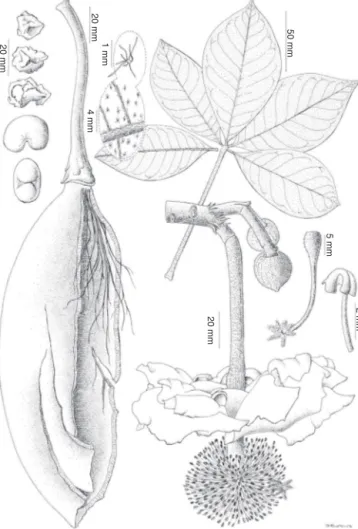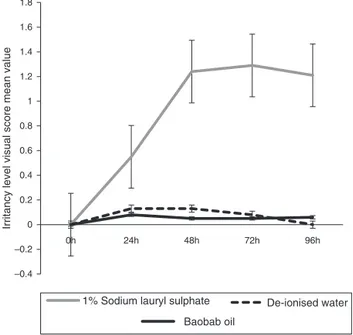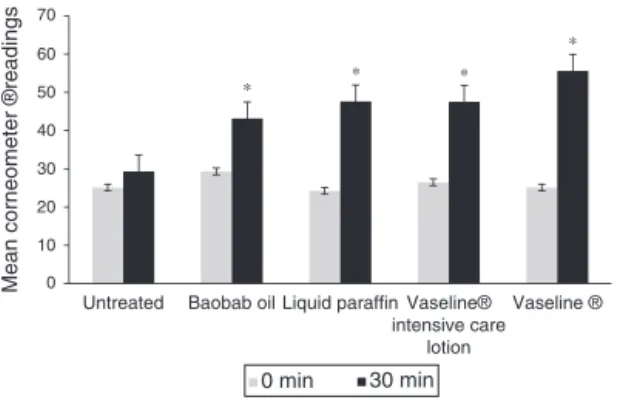w ww . e l s e v i e r . c o m / l o c a t e / b j p
Original
Article
Beauty
in
Baobab:
a
pilot
study
of
the
safety
and
efficacy
of
Adansonia
digitata
seed
oil
Baatile
M.
Komane
a,
Ilze
Vermaak
a,b,
Guy
P.P.
Kamatou
a,
Beverley
Summers
c,
Alvaro
M.
Viljoen
a,b,∗aDepartmentofPharmaceuticalSciences,FacultyofScience,TshwaneUniversityofTechnology,Pretoria,SouthAfrica
bSouthAfricanMedicalResearchCouncilHerbalDrugsResearchUnit,FacultyofScience,TshwaneUniversityofTechnology,Pretoria,SouthAfrica
cDepartmentofPharmacy,PhotobiologyLaboratory,SefakoMakgathoHealthSciencesUniversity,Pretoria,SouthAfrica
a
r
t
i
c
l
e
i
n
f
o
Articlehistory:
Received31May2016 Accepted14July2016 Availableonline12August2016
Keywords:
Adansoniadigitata
Baobab Cosmetic Efficacy Safety Seedoil
a
b
s
t
r
a
c
t
Recentlytherehasbeenarenewedimpetusinthesearchfornovelingredientstobeusedinthecosmetic industryandBaobab(AdansoniadigitataL.,Malvaceae)seedoilhasreceivedhighinterest.Inthisstudy, acommercialBaobabseedoilsamplewascharacterised(fattyacidcontent)usingGCxGC-ToF-MSanda pilotstudyonthesafetyandefficacyoftheseedoilwasperformed.ThesafetyandefficacyofBaobabseed oilaftertopicalapplicationwasdeterminedusinghealthyadultfemalecaucasianparticipants(n=20). A2×magnifyinglampwasusedforvisualanalysis,whileformonitoringandevaluationoftheirritancy level,transepidermalwaterloss(TEWL)andhydrationleveloftheskin,Chromameter®,Aquaflux®and Corneometer®instruments,respectively,wereused.Inaddition,Aquaflux®andCorneometer® instru-mentswereusedtoassessocclusiveeffects.ThirteenmethylesterswereidentifiedusingGCxGC-ToF-MS. Themajorfattyacidsincluded36.0%linoleicacid,25.1%oleicacidand28.8%palmiticacidwith10.1% constitutingtracefattyacids.Theirritancyofsodiumlaurylsulphate(SLS)inthepatchtestdiffered significantlycomparedtobothde-ionisedwater(p<0.001)andBaobabseedoil(p<0.001)butthe dif-ferencebetweentheirritancyofBaobabseedoilandde-ionisedwaterwasnotsignificant(p=0.850). ThemoistureefficacytestindicatedareducedTEWL(p=0.048)andanimprovedcapacitancemoisture retention(p<0.001)forallthetestproducts(Baobaboil,liquidparaffin,Vaseline®intensivecarelotion andVaseline®).Theocclusivitywipe-offtestindicatedanincreasedmoisturehydration(p<0.001)and decreasedTEWLparticularlywhenBaobaboilwasapplied.Baobabpossesseshydrating,moisturisingand occlusivepropertieswhentopicallyappliedtotheskin.Baobabseedoilcouldbeavaluablefunctional ingredientforcosmeceuticalapplications.
©2016SociedadeBrasileiradeFarmacognosia.PublishedbyElsevierEditoraLtda.Thisisanopen accessarticleundertheCCBY-NC-NDlicense(http://creativecommons.org/licenses/by-nc-nd/4.0/).
Introduction
TheBaobab(AdansoniadigitataL.,Malvaceae)tree,whichhas beenusedextensivelyasasourceoffood,fibreandmedicine,is commonlyreferredtoas“arbreapalabre”,meaningtheplacein thevillagewheretheeldersmeettoresolveproblems(Kamatou etal.,2011).Thisdeciduoustreeisapproximately23mtalland hasasmooth,reddish-brown,greyish-brownorpurplish-greybark withgreensimpleordigitateleavesthatalternateattheendsofthe branchesfollowedbyprogressively2–3foliolateleaves.The flow-ersarependulouswithfivewhitepetalswhilethepulp-containing fruits are apex-pointed,covered by velvety pale yellow-brown hairswithsmoothdarkbrowntoblackishseedscoveredby cream-colouredkernels(Fig.1)(Palgrave,1983;WickensandLowe,2008;
∗ Correspondingauthor.
E-mail:viljoenam@tut.ac.za(A.M.Viljoen).
Kamatouetal.,2011).TheBaobabtreebelongstoapan-tropical familywithsixoftheeightspeciesspanningMadagascar,the sev-enthspeciesisendemictonorth-westernAustraliaandtheeighth speciesiswidelyspreadinsub-SaharanAfrica.InsouthernAfrica (Fig.2),BaobabisfoundinAngola,Zambia,Mozambique,Zimbabwe andSouthAfrica(Limpoporegion)(WickensandLowe,2008;Rahul etal.,2015).
InSouthAfrica,theBaobabandMarulaaretwoofthemost pop-ularindigenoustreespeciesusedforseedoilproduction(Venter, 2012).Theseedoilextractedfromthebaobabfruitpulpispopularly usedinthecosmeticsindustryandsoldinternationally(Munthali etal.,2012).About33%oftheseedcontentisoilwitholeicand linoleicacids asthemajorfattyacids followedby palmiticand
␣-linolenicacids.Thehighcontentoflinoleicandoleicacidsare
knowntosoftentheskinandtorestoreandmoisturisethe epider-mis.Inaddition,thefattyacidsregenerateepithelialtissueswhich renderstheseedoilaverygoodcarrieroilofvaluetothecosmetic industry(Glewetal.,1997;Chindoetal.,2010).
http://dx.doi.org/10.1016/j.bjp.2016.07.001
20 mm
20 mm
4 mm
1 mm
20 mm
50 mm
5 mm
2 mm
Fig.1.BotanicallinedrawingillustratingthediagnosticfeaturesofAdansonia digi-tata(Baobab).
Angola
Zambia
Mozambique
Namibia
Botswana
Swaziland
Lesotho
South Africa
Zimbabwe
Fig.2.DistributionmapofAdansoniadigitata(Baobab)insouthernAfrica.
Theseedoilhasbeenusedforcenturiesbylocalcommunitiesfor food,medicineandcosmeticapplications.Thenutritionalseedsare richinproteinandtheoilisgenerallyusedinfoodpreparationfor sauce/pasteoreatenraw/roasted(Osman,2004).Ithasbeenused toproducelubricants,soapsandtoothpaste,inthetopical treat-mentofvariousconditionssuchasmusclespasms,varicoseveins andwoundsandappliedasamoisturiserforskinhydration,for hairandnailconditioningandtotreatdandruff(Zimbaetal.,2005; Nkafamiyaetal.,2007;Chindoetal.,2010).SidibeandWilliams (2002)reportedthattheBaobabseedoilisusedforcosmetic appli-cationstotreatskinailments.TheBaobabtreehasbeenreferred toasa smallpharmacyorchemisttreeandmanyauthorshave reportedthatallBaobabplantpartsarevaluable(Gebaueretal., 2002;DeCaluwéetal.,2010).
Baobaboil, extractedfromtheseed,isusedinthecosmetics industryand isalsosoldinternationally eventhough thereis a lackofclinicalstudiestoconfirmitstraditional use(Gruenwald andGalizia,2005).TheglobaldemandforBaobaboilhasgrown substantiallywithexportstoEurope,AsiaandNorthAmerican mar-kets.InZimbabwe,approximately20,000litresofBaobaboilworth $100,000 is producedannually (Kamatouet al.,2011; Vermaak etal.,2011;Venter,2012).InSouthAfrica,commercialisationofthe seedoilstartedasearlyas2005attheVhembeMunicipalDistrictin theNorthernregionofVendawhereseedsweresoldatlocal mar-ketsandtheoilsextractedfromtheseedsweresoldtothecosmetic market(VenterandWitkowski,2010).
Therehavebeenseveralreportsonthephysico-chemical prop-erties, nutritionalcontent and fattyacidprofile ofthe seed oil using conventional methods such as gas-chromatography cou-pledtomassspectrometry(GC–MS)(SidibeandWilliams,2002; DeCaluwéetal.,2010).Comprehensivetwo-dimensional analy-siswhichprovidesbetterseparationcouldgivefurtherinsightinto thecompositionasitcanidentifyfattyacidspresentintrace-level concentrations.Thisstudycharacterisedthefattyacidcomposition ofcommerciallyavailableBaobabseedoilsubsequentlyusedina pilotstudytodetermineitssafetyandefficacy.
Materialsandmethods
Materialsandsamplepreparation
RefinedBaobabseedoil(Batchnumber:BAO0311EP;Product code: PDBAOADO1)waspurchased froma reputable commer-cial supplier (Scatters® Oils). Scatters® Oils (South Africa) is a supplierand exporterof natural, indigenousorganicoilstothe localandinternationalmarket(http://www.scattersoils.com/).The odourless yellow seed oil was stored at 2–8◦C and allowed to warm up to room temperature before commencement of thepilotstudy.Thecertificateof analysisindicated arefractive indexof1.476(1.474–1.485)andarelativedensityof0.894g/ml (0.892–0.950g/ml). A retention sample (BAOB005) is stored in theDepartmentofPharmaceuticalSciences,TshwaneUniversity ofTechnology.Afattyacidmethylesters(FAMEs)37-component standard mixture aswell aspure(≥99.0%) referencestandards (linoleic,oleic,palmitic,stearic,arachidic,linolenicandmyristic acid)wereobtainedfromSigma–Aldrich® (Johannesburg,South Africa).TheFAMEswerepreparedusingthemodifiedmethodof Rossé and Harynuk(2010).A volumeof 310l ofthe oil
sam-pleandthestandards(n=7)wereseparately preparedina vial andmixedwith500lof2.8gpotassiumhydroxidein100mlof
methanolsolution(stocksolution)andsonicatedfor30minina waterbathat60◦C.Boron-triflouride(1000
l)inmethanolwas
usedasacatalystandthemixturewassonicatedagainfor30min at60◦C.Petroleumether(1000
l)andsaturatedsodiumchloride
5minat10,000rpmat5◦C(Kothiyaletal.,2010).Thesupernatant wascollectedandanalysedusingtheGCxGC-ToF-MSsystem.
Theirritancypatchtestwasconductedusing1%sodium lau-rylsulphate(SLS)(≥99.0%purity;Sigma–Aldrich®,Johannesburg, SouthAfrica)solutionasapositivecontrol(irritant)andde-ionised waterasanegativecontrol.Forthemoistureefficacy,hydration andocclusivitytests,liquidparaffin(≥95%),Vaseline® intensive carelotion(MSDS#4059)andVaseline® petroleumjelly(MSDS #4056)obtainedfromUnilever© Pty Ltd(Durban, SouthAfrica) wereusedaspositivecontrolswhileuntreatedskinwasregarded asthenegativecontrol.
GCxGC-ToF-MSanalysis
TheGCxGC-ToF-MS(LECO®Pegasus4D,LECOAfrica,Pretoria) wasequipped with an Agilent GC (7890), Gerstel Autosampler (MPS2), a secondary oven and a dual stage modulator. Liquid nitrogencoolingwasusedforthecoldjetsandsyntheticairfor the hot jets. Separation of target compounds was achieved on apolarStabilwax® polyethyleneglycolcolumn(30m
×0.25mm i.d.×0.25mfilmthickness)(Restek,USA)inthefirstdimension
coupledwithanon-polarRxi®-5SilMScolumn(0.79m
×0.25mm i.d.×0.25mfilmthickness(RestekUSA)intheseconddimension.
Primaryandsecondarycolumnswereconnectedusingapress-tight connector.Helium(99.9999%purity)wasusedascarriergasata constantflowrateof1.4ml/minandthesplitinjectorwassetto 1:200.Themainoventemperaturewasinitiallysetto40◦C for 1min,andthenrampedto260◦Cat10◦C/min,withafinal isother-malperiodof2minat260◦C.Thesecondaryovenwasprogrammed witha+15◦Coffsetabovetheprimaryoven.TheGCtemperature programmeandMSmethodwasdevelopedtoutilise theadded selectivityofGCxGCandthefullrangemassspectrageneratedby ToF(timeofflight)-MSforseparatingandidentifyingcomponents. Differentmodulationperiods(2s,4s,5s,6sand8s)weretested duringtheoptimisationstagetodeterminethebestseparation.The chosenmodulationperiodwas2.0sandthehotpulsedurationwas setat0.5s.Themassspectrometerwasoperatedatanacquisition rateof100spectra/s.Asolventacquisitiondelayof180swasused toprotecttheMSanalyserfromexcessivesolventexposure.The ionsourcetemperatureandthetransferlinetotheToF-MSwere setto200◦Cand280◦C,respectively.Thedetectorvoltageusedwas 1650Vandelectronionisationat70eVwasused.Massspectrawere acquiredfrom30to450m/zand1l(1:50dilution)ofthesample
wasinjectedinduplicateusingtheGerstelmultipurposesampler. Thepercentageareawasautomaticallycalculatedbythesoftware takingintoaccountpeakheight,area,widthandthenoiselevel. Identificationofpeakswasbasedonretentiontimesofreference compounds(linoleic,oleic,palmitic,stearic,arachidic,linolenicand myristicacidaswellasthe37-componentmixture)andmass spec-tralibrarymatchingusingNIST®MassSpectralLibrary(NIST®11) andNIST®08(AdamsLibrary).Librarysimilarityfactorswere deter-minedforbothforwardandreversesearches.
Pilotstudy
Patientselectionandstudydesign
Threesingle-blind quantitativepilot studies (irritancypatch test, moistureefficacy and occlusivity studies) wereconducted betweenJulyandSeptember2014.Foreachstudy,twenty(n=20) healthyCaucasianadultfemalevolunteers(18–65yearsold)who compliedwiththeinclusionandexclusioncriteriawererecruited. Exclusion criteria comprised the following: known allergy to moisturisers,creams,lotionsorcleansingproducts;useof med-icationwhichmayinfluencetheinterpretationofthedatasuch astopical/systemiccorticosteroids,chronicantihistaminesand/or anti-inflammatories; useof anytopicalmedications onthetest
areas;clinicallysignificantskindiseaseswhichmaycontraindicate participation,includingpsoriasis,eczema,skincancerorotherskin pathology;damagedskininoraroundthetestareassuchas sun-burn,excessivesuntan,unevenskintones,scars,cuts,scratches, varicoseveins,tattoos,activedermallesions,orother disfigura-tionofthetestareathatwouldinterferewithvisualevaluations; immunologicaldisorderssuchasrheumatoidarthritis,HIVpositive status,AIDSorsystemiclupuserythematosus;insulin-dependent diabetes;anycondition,whichintheopinionoftheinvestigator mayaffecttheresultsorplacethesubjectatunduerisk;becurrently pregnant,planningapregnancy,lactating,orhavegivenbirthinthe last4weeks;peripheralvasculardisease;and/orparticipatedina studyinvolvingthesametestareawithinthethreeweekspriorto thedry-downperiod.
Signed informed consentwas obtainedfromall participants priortothecommencementofthestudy.Allstudieswere con-ducted at the Photobiology Laboratory according to Standard OperatingProceduresandcarriedoutinaccordancewiththe Dec-larationofHelsinkiand theGuidelinesforGood Practicein the ConductofClinicalTrialsinHumanParticipationinSouthAfrica. Permission to conductthe studywas granted by theResearch, EthicsandPublicationsCommitteeoftheSefakoMakgathoHealth Sciences University (MREC/H/48/2014: CR) and the study was approvedbytheSenateCommitteeforResearchEthicsatTshwane UniversityofTechnology(SCRE/2014/06/008).
Irritancypatchtest
Theirritancypatchtestwasconductedonthevolarforearm. Baobab oil (20l), de-ionised water (negative control) and 1%
sodiumlaurylsulphate (positivecontrol)wereappliedtopically usingwhitelitmuspaper(5mm×10mm)andplacedontheskin inFinnchambersandkeptinpositionfor2×23huntilassessment. Reassessmentwasconductedforanyirritant(notanallergic) reac-tionafterafurther48h.Reactionsweregraded;0.0=noreaction, 0.5=slightreaction,1.0=weakreaction,1.5=moderate reaction, 2.0=strongreaction)foreachirritant.Thevisualassessmentwas carriedoutusinga2×magnifyinglampforvisualscoringanda MinoltaCr400Chromameter®wasusedtoassessthesurfacecolour basedonthetristimulusanalysisofthereflectedxenonlightpulse usingtheL*a*bsystem.TheL*valueistheluminancevariablewhile a*andb*valuesarethechromaticityco-ordinates;red-green(a*) andblue-yellow(b*).Thevaluesareusedtodefineapointina three-dimensionalcolourspacethatcharacterisesacolour(Abuaglaand Al-Deeb, 2012).In this study a* value (redness) readings were recorded.
Irritancy levels were classified as follows: mean visual score+one standard deviation (SD)>1.5=sample is an irritant; meanvisualscore+SD≤1.5and>negativecontrol=samplehaslow irritancypotential;and,ameanvisualscore+SD≤negative con-trol=sampleisnon-irritant.Toquantifytheskinresponseforeach testsitecomparedtobaseline,thea*valuereadingswere calcu-latedat0,24,48,72and96hpostapplication;usingtheequation:
Delta a∗
=(product a∗
timet−product a∗ time0)
− (untreateda∗timet
−untreateda∗time0) (1)
TheDeltaa*valuesforallparticipantsforagivenproductata giventimepointwereaveragedandplotted(Spiewak,2008).
Moistureefficacystudy
lampwasusedforvisualassessment;anAquaflux®(BioxSystems Limited,London)instrumentwasusedtodeterminetheTEWLand skinbarrierefficacy;andaCorneometer®
(CourageandKhazaka, ElectronicGmbH,Khöln,Germany)wasusedtorecordmoisture retentionreadingsanddetermineskinbarrierfunction.Priortothe commencementofthestudy,participantswereexposedtoa7-day dry-downperiodwherethecalfareawaswashedina standard-isedway2–4timesdailyusingsoapandwateronly.Participants werenotallowedtoapplyanyproductstothelegsduring this period.Afterthe7-daydry-downperiodanamountof0.1mlof eachsamplewasappliedtwicedailyon5.7cm×3.7cmrandomised testsites(Untreated,Baobaboil,liquidparaffin,Vaseline®intensive carelotionandVaseline®
petroleumjelly)incircularmovements onthecalfareaoveradiameterof20mm.Thelaboratory techni-cianappliedthetestproductsinthemorningandAquaflux®and Corneometer®
readingswererecorded.Theparticipantsre-applied theproductsathomeafterbathingapproximately8hlater. Assess-mentswereperformedondays1,2,3,4,5,8,10and12.
Visualassessment
Beforeapplication,baseline readingsweretakenat0husing a 2× magnifying lamp for visual scoring.Visual assessment of skindryness wasbased on thefollowing grading: 0.0=no evi-denceofdryness;1.0=slightlydryskin;2.0=moderatelydryskin; 3.0=severelydryskin;and4.0=extremelydryskin.Visual assess-mentswereperformedondays1,2,3,4,5,8,10and12.Theraw dataobtainedfromvisualassessmentreadingsforeach testsite comparedtobaseline,wascalculatedusingEq.(1).
Aquaflux®transepidermalwaterloss(TEWL) TheAquaflux®
instrumentwasusedtomeasurewater evap-oration from the calf area based on the vapour pressure i.e. transepidermalwaterloss(TEWL)(Imhof,2007;Farahmandetal., 2009).Inmostcases,iftheskinwaterbarrierisdamagedtheTEWL readingwillbeincreased.Thetestproductswereappliedonthe fivetestsitesandreadingswererecordedondays1,2,3,4,5,8, 10and12.Aquaflux®assessmentsforeachtestsitecomparedto baseline,wascalculatedusingEq.(1).
Capacitance–Corneometer®moistureretention(hydration) The Corneometer® instrument records the concentration gradientof water inthestratum corneum basedonthe capac-itive measurement of the di-electrical constant of the stratum corneum.Thehydrationofthestratumcorneumisrelatedtothe suppleness,softnessandsmoothnessaswellastheyouthfuland healthyappearance ofthe skin(Jiangand Delacruz, 2011).The readingsrangefrom0(nomoisture/water)upto120(highlevel
ofmoisture/water)(Clarysetal.,2011).Thevaluesaregenerally classifiedunderdifferentcategorieswithextremedrynessbeing rated<30,drybeingbetween30and40andnormal>40(Heinrich etal.,2003).Thetestproductswereappliedtothefivetestsites andreadings wererecordedondays1,2, 3,4,5,8, 10and 12. Corneometer®assessmentsforeachtestsitecomparedtobaseline, wascalculatedusingEq.(1).
Occlusivitystudy
Awipe-offtestwasconductedonthevolarforearmforfive con-secutivedaysusingAquaflux®andCorneometer®instruments.Five testsites(Untreated,Baobaboil,liquidparaffin,Vaseline® inten-sivecarelotionandVaseline®petroleumjelly)wererotationally randomisedand0.1mlofeachsamplewasappliedtotheskin sur-face(20mmdiameter)usingcircularmovements.Readingswere recordedat0minand30minpostwipe-offperiodandEq.(1)was usedforcalculationoftheDeltaa*value(Spiewak,2008).
Dataanalysis
Statistical analyses were performed using Stata® 10 data software.ThePearson’schi-squaretestwasusedtotestfor asso-ciations betweenthe samples and the reaction categories. The Kruskal–Wallistestwasusedtocomparesamplesovermeasured outcomesincaseswheretheoutcomeisnotnormallydistributed. Otherwise,two-sampleindependentt-testsorone-wayanalysisof variance(ANOVA)testswereemployedforcontinuousand nor-mally distributedoutcomes.Where asignificantdifference was observed;aSidekposthoctestwasperformed.Allthe interpre-tationsareperformedat˛=0.05errorrate.
Resultsanddiscussion
GCxGC-ToF-MSanalysis
Table1showsthethirteen(13)methylestersidentifiedthrough comparisontothemassspectroscopydataofthestandardsand standardsmixturefromtherefinedBaobabseedoilcharacterised usingtwo-dimensionalgaschromatography.Theaverage percent-ageofsaturatedfattyacidspresentintheoilsamplewas34.6%with 28.7% monounsaturated and 36.7% polyunsaturated fatty acids. Majorsaturatedfattyacidsidentifiedintheoilsampleincluded palmitic(28.8%)andstearic(4.4%)acids.Unsaturatedfattyacids including monousaturated oleic acid (25.1%) and a high quan-tityofpolyunsaturatedlinoleicacid(36.0%)wasdetected.Other studiesreportingthefattyacidcontentofbaobabseedoilused one-dimensionalGC–MSforquantification.DeCaluwéetal.(2010) reported that themajor fatty acids present in baobab seed oil
Table1
FattyacidcompositionofAdansoniadigitatacommercialoilasdeterminedbyGCxGC–MS.
Fattyacidsdetected Chemicalname Molecular
formula
Carbon bonds
Percentagedetected (%)±standard deviation
Retentiontime 1stDimension (s)
Retentiontime 2ndDimension (s)
Pelargonicacid Nonanoicacid,methylester C9H18O2 C9:0 0.05±0.07 502 0.74
Myristicacid Tetradecanoicacid,methylester C18H34O2 C14:0 0.1±0.14 852 0.82
Palmiticacid Hexadecanoicacid,methylester C16H32O2 C16:0 28.5±0.42 972 0.85
Palmitoleicacid 7-Hexadecenoicacid,methylester,(Z)- C16H30O2 C16:1 0.25±0.07 984 0.8
Heptadecanoicacid Heptadecanoicacid,methylester C17H34O2 C17:0 0.17±0.04 1026 0.86
cis-10-Heptadecenoic acid
cis-10-Heptadecenoicacid C17H32O2 C17:1 0.58±0.02 1036 0.82
Linolelaidicacid 9,12-Octadecadienoicacid,methylester,(E,E)- C18H32O2 C18:2n6t 0.18±0.03 1058 0.77
Stearicacid Octadecanoicacid,methylester C18H36O2 C18:0 5.85±2.05 1080 0.88
Oleicacid 9-Octadecenoicacid,methylester,(Z)- C18H34O2 C18:1n9c 25.66±0.95 1090 0.83 Linoleicacid 9,12-Octadecadienoicacid,methylester,(Z,Z)- C18H32O2 C18:2n6t 35.75±0.35 1110 0.8 Linolenicacid 9,12,15-Octadecatrienoicacid,methylester,(Z,Z,Z)- C18H30O2 C18:3n3 0.5±0.00 1142 0.75 Elaidicacid 9-Octadecenoicacidmethylester(E)-, C18H34O2 C18:1n9t 2.8±0.00 1144 0.86
werepalmitic(27%),linoleicacid(27%)andoleic(25%)acidswhile
NamrathaandSahithi(2015)reported36%oleicacid,33%palmitic acidand31%linolenicacid.Areviewarticlefurtherreportedthat oleicacidinbaobabseedoilsamplesrangedfrom30to42%,linoleic acidfrom20to35%andpalmiticacidfrom18to30%,(Vermaak etal., 2011).Fattyacidsare consideredtobea combination of triglyceridesofhighersaturatedandunsaturatedfattyacids.These compoundsareestersofglycerolandhigherfattyacids contain-ing longaliphatic carbonchains. Depending ontheirfatty acid percentagestheymayexhibitavarietyofpropertieswhichcould bebeneficialtotheskinduringdailycosmeticuse(Zieli ´nskaand Nowak,2014).Withhighpercentagesofpalmitic(unsaturated), oleic(monounsaturated)andlinoleic(polyunsaturated) acidsas detectedin theBaobabseedoil,thefindingscouldsuggestthat theseedoilisofgreatimportanceasacosmeticbasetoprevent transepidermalwaterlossby creatingaprotective layeronthe epidermis(Zieli ´nskaandNowak,2014).Inaddition,linoleicacid (polyunsaturatedfattyacid)isanaturalcomponentofsebumand playsasignificantroleinstrengtheningthelipidbarrierofthe epi-dermisandnormalisestheskinmetabolism(Zieli ´nskaandNowak, 2014).Furthermore,thepresenceoflinoleicacidintheceramides ofthestratumcorneumdirectlycorrelateswiththepermeability barrierfunctionoftheskin(Stages,2012).Kanlayavattanakuland Lourith(2011)reportedthatBaobabseedoilcouldberegarded asapotentialtherapeutictopicalapplicationforacne treatment duetothehighpercentageoflinoleicacidpresent.Theoil sam-plecontained36%omega-6(linoleicacid)whichhasbeenshown tocontributetowardsmaintainingahealthyskinparticularlywhen topicallyappliedincasesofacne.Theapplicationoflinoleicacidfor oilyandproblematicskinmayresultinimprovedsebaceousgland functionandthepreventionofcomedo-acneformation(Zieli ´nska andNowak,2014).
Irritancypatchtest
Irritancypatchtestingistheprincipletestdemonstrating irri-tantcontactdermatitis.Anirritantisasubstancethatwouldcause inflammationinalmosteveryindividualifappliedinhigh concen-trationforalongperiodandwillresultinanirritantreactionbut willnotinfluencetheimmunesystem(Lewis,2014).Visual ery-themaassessment(Fig.3)revealedthatsodiumlauryl sulphate (positivecontrol)washighlyirritatingtotheskin,asexpected,at alltimeintervalswhilede-ionisedwaterandBaobaboilwere non-irritatingwithlowerythemascores.Thevisualgradingscoresof de-ionisedwater(negativecontrol)were0.13(24h),0.13(48h), 0.08(72h)and0.00(96h)whiletheresultsyieldedafter applica-tionofBaobaboilwere0.08(24h),0.05(48h),0.05(72h)and0.06 (96h).De-ionisedwaterischemicallyprocessedwaterusing ion-exchangeresinanditisconsideredsuitableforthemanufacturing ofcosmetics.Inrecentyears,Baobaboilhasbeenaddedtothelistof fixedoilscommonlyincludedincosmeticproductsduetoitshigh contentofpalmiticandoleicacids(Bazongoetal.,2014).
The visual erythema assessment results were corroborated throughtheChromameter®results. Sodiumlaurylsulphate(1%) washighlyirritating,withaverageincreasedchromaa*readings of1.97(24h)4.81(48h),5.15(72h)and4.52(96h),respectively (Fig.4)comparedtobaselinereadingsof0.64(24h)1.05(48h), 0.11(72h)and 0.73(96h).Baobaboilwasnon-irritatingtothe skinwithreadingsof0.33(24h),0.67(48h),0.51(72h)and0.51 (96h).Althoughde-ionisedwaterwasalsonon-irritatingatalltime points,theobservedreadingsat48,72and96hwereslightlyhigher thanBaobaboilwithvalues of1.15,0.96 and0.74 respectively. ThesefindingscorrelatedtoareportpublishedbyBurnett(2010) intheCosmeticIngredientReview(CIR,2011)duringwhich100% Baobaboilwastestedfordermalirritationpotentialusingthe Mat-TekEpiDermTMMTTviabilityassaywheretissueviabilityindicates
–0.4 –0.2 0 0.2 0.4 0.6 0.8 1 1.2 1.4 1.6 1.8
0h 24h 48h 72h 96h
Irritan
cy
level
visu
al
score
mean
value
1% Sodium lauryl sulphate De-ionised water
Baobab oil
Fig.3.Irritancylevelvisualscoremeanvaluewhen1%sodiumlaurylsulphate (pos-itivecontrol),de-ionisedwater(negativecontrol)andBaobaboil(testproduct)was appliedonthevolarforearmareaat24,48,72and96htimeinterval(n=19).
skinirritationpotentialoftestmaterials.TheMatTekEpiDermTM tissuesampleswereincubatedwith100lofthetestmaterialfor
1,4and24htogetherwiththepositivecontrol(1%TritonX-100) whichwasincubatedfor4or9h,andthenegativecontrol(undosed tissuesincubated for4h). Thepositive controlcausedexpected irritationwhileBaobaboilcausednoirritation(Burnett,2010).
Moistureefficacytest
Visualassessment(2×magnifyinglamp)
TheresultsinFig.5indicatedthatskindrynessrecoverywas significantforalltestproductscomparedtountreatedskinwith Vaseline® intensivecarelotionshowingthehighestskin recov-erypotential.Baobaboilandliquidparaffinexhibitedsimilarskin recoveryproperties.Baobaboiliswellknownforitsnon-siccative (non-drying) property and contains palmitic, oleic and linoleic acidswhichrendersitasuitablecosmeticoilforthepreventionof skindryness(PhytoTradeAfrica,2012).Thesmallmolecular struc-tureresultsinrapidabsorptionandpalmiticandoleicacidshave
∗ Significant difference (
P=.005) between Baobab oil and 1% sodium lauryl sulphate –1
0 1 2 3 4 5 6 7
24h 48h 72h 96h
Chromameter
a
∗m
ean
v
alue
change
from
b
aseline
Baobab oil De-ionised water 1% Sodium lauryl sulphate
∗
∗
∗
∗
Fig.4. Chromameter®
0 0.5 1 1.5 2 2.5 3
Vaseline® intensive care
lotion Liquid paraffin Baobab oil
Untreated Vaseline ®
Mean
Visual
skin
dr
y
ness
score
Day 1 Day 12
∗
Significant difference (P=.005) observed when baobab oil, liquid paraffin, Vaseline® intensive care lotion and Vaseline® were compared at Day 1 and 12.
∗ ∗
∗
∗
Fig.5.VisualskindrynessscorereadingsatDay1and12(n=20).
0 2 4 6 8 10 12 14 16 18 20
Vaseline® intensive care
lotion Liquid paraffin Baobab oil
Untreated Vaseline ®
∗ Significant difference (
P=.005) observed when baobab oil, liquid paraffin, Vaseline® intensive care lotion and Vaseline® were compared at Day 1 and 12.
TEWL
g/[m2h]
mean
readings
∗ ∗
∗ ∗
Day1 Day 12
Fig.6. MeanTEWLg/[m2h]readingsatDay1and12(n=20).
beenreportedtobeeffectivepercutaneousabsorptionenhancers. Itwasfurtherreportedthatlinoleicacid(36.0%inthetestsample) isthemostfrequentlyusedfattyacidincosmeticproductsasit moisturisestheskinandaidsinthehealingprocessofdermatoses andsunburns(Bazongoetal.,2014).
Aquaflux®
transepidermalwaterloss(TEWL)
AllofthetestproductssignificantlyreducedTEWLoveratest periodof12days(Fig.6).Vaseline®wasparticularlyeffectivewith ahighnegativevalueof−6.32observedatchangefrombaseline (D12−D1).Liquidparaffin(−4.84)andBaobaboil(−4.07) exhib-itedsimilareffectivitywhileVaseline®intensivecarelotionwasthe leasteffectiveat−3.53(Table2).Negativevaluesconfirmthatskin barrierpropertiesofthetestproductshadanefficientimpacton TEWL.Ahealthyskinhasahealthybarrierfunctionwhichdepends onlipidsthatarepresentinthecorneocytes.Anycauseoflipid con-tentreductionwillleadtoacompromisedbarrierandanincreased
∗ Significant difference (P=.005) observed when baobab oil, liquid paraffin
and Vaseline® intensive care lotion were compared at Day 1 and 12. 0
5 10 15 20 25 30 35
Vaseline® intensive care
lotion Liquid paraffin Baobab oil
Untreated Vaseline ®
Mean corneometer® readings
Day1 Day 12
∗
∗ ∗
Fig.7.MeanCorneometer®
readingsatDay1and12(n=20).
TEWL(Bouwstra andPonec, 2006).Baobab oilis consideredan excellentoiltoimproveskinbarrierfunctionbypreventingreduced TEWLthatoccursasaresultofanimpairedbarrier,duetoitshigh saturatedandunsaturatedfattyacidcontent(Kamatouetal.,2011). In2005,VenterreportedthatBaobaboilisagoodqualitynatural moisturiserasdeterminedthroughasurveyconductedintheLouis Trichardt(intheLimpopoProvinceof SouthAfrica)VhaVhenda regionwheretheuseofEcoproducts©oilswereincludedas ingre-dientsinbathsoaps,bodylotionsandfacemoisturisers(Hametal., 2010).InarecentpatentbyEngelsandGladbach(2009),an addi-tivefromtheBaobabplantwasusedinformulationsofcosmetic anddermatologicalemulsionsforskincareasamoisturiserthat createsafeelingofsmoothnessontheskin.
Capacitance-Corneometer®
moistureretentiontest(hydration) Techniques forthe assessment of skinhydration are mostly based onthe electrical propertiesof the stratum corneum and theCorneometer®
instrument is regarded asthe most popular approachtomeasureskinmoisture(Lodénetal.,1995).Theresults (Fig. 7)indicated that significantly higher mean valuereadings wererecordedforthreeofthefourtestproductsonday12with Vaseline®intensivecarelotionreadingsthehighestat30.56 fol-lowedbyBaobaboilat20.28andliquidparaffinat19.61.There wasnosignificantdifferencerecordedforVaseline®withamean readingonday1of19.70and20.18onday12.Baobaboilwasless hydratingthanVaseline®intensivecarelotion.Thesefindingscould beattributedtothenatureofVaseline®intensivecarelotionbeing awaterinoilemulsionthatsignificantlyinducechangesinskin capacitancecomparedtoBaobaboilwhichisalipid-richocclusive product,richinessentialfattyacids(palmitic,oleicandlinoleic) and hastheability topenetrate into theepidermiswith bene-fitsofrestoringtheintegrityoftheskincellmembrane(Johnson, 1981;JemecandWulf,1999).Thehighconcentrationofthelinoleic andoleicacidspresentinBaobaboilrendersitanexcellentskin regeneratingseedoilthatmimicsthethreeskinmechanismsof hydration,reinforcingthefunctionalityofthelipidicmantlewith lipophilicsubstances thus increasingthecapacity tolink water throughhydrophilicsubstancesandimprovingskindefencewhich
Table2
TEWLmeanreadingsatday1andday12(n=20).
Testproducts Day1:Meanvalue±standarddeviation Day12:Meanvalue±standarddeviation ChangefrombaselineD12−D1
Untreated 11.86±2.21 16.77±2.79 4.91
Baobaboil 15.14±4.22 11.07±2.26 −4.07
Liquidparaffin 16.53±3.13 11.69±2.11 −4.84
Vaseline®intensivecarelotion 15.23
±3.88 11.70±2.18 −3.53
Vaseline® 17.00±3.02 10.67±2.67a −6.32
aVaseline®
∗ Significant difference (
P<.005) observed when Vaseline® intensive care lotion,
Vaseline® , liquid paraffin and Baobab oil were evaluated for moisture retention level at time 0 min pre and immediate post wipe off at 30 min
0 10 20 30 40 50 60 70
Vaseline® intensive care
lotion Liquid paraffin Baobab oil
Untreated Vaseline ®
Mean corneometer ®readings
∗ ∗ ∗
∗
0 min 30 min
Fig.8.MeanCorneometer®
readingsforalltestproductsattime0minpreand immediatepostwipeoffat30min(n=20).
∗ Significant difference (
P<0.005) observed when Baobab oil, liquid paraffin and vaseline® was evaluated for TEWL level at time 0 min pre and immediate post wipe off at 30 min
0 2 4 6 8 10 12
Vaseline® intensive care
lotion Liquid paraffin
Untreated Vaseline ®
TEWL
[g/m2h]
mean
readings
∗
∗
∗
∗
0 min 30 min Baobab oil
Fig.9.MeanTEWLg/[m2h]readingsofalltestproductsattime0minpreand
immediatepostwipeoffat30min(n=20).
makestheseedoilaverygoodcarrieroilandanessentialingredient inthecosmeticindustry(Theodore,1989;Darlenskìetal.,2011).
Fig. 8 reflects the occlusion potential in a 30-min wipe-off test. All test products improved moisture retention. Vaseline® demonstratedthebestmoistureretention propertyfollowedby liquidparaffin,Vaseline®intensivecarelotionandBaobaboil.The occlusionproperties arefurtherillustrated in Fig.9.Baobab oil applicationcaused a reductionin theTEWLvalue witha mean reading of4.77g/[m2h].In contrast,Vaseline® intensivecareat 6.62g/[m2h], liquid paraffin at 9.32g/[m2h] and Vaseline® at 0.25g/[m2h]causednoreductioninTEWL.Vaseline® isa well-knownpetrolatumthathasbeenusedasaningredientforover50 yearstosmoothenoutskinsurfaceduetoitsocclusiveproperty thatcausesmoisturetoaccumulateinthestratumcorneumthus preventingabnormaldesquamatingpropertyoftheskin(Kligman, 1978;Burton,1983).Yet,accordingtoEngelsandGladbach(2009), baobabisregarded asapreferred oilin skincareproductsdue toitsrevitalising,moisturisingandrestructuringpropertiesasa resultofthebalanceinthesaturated(palmitic)monounsaturated (oleic)andpolyunsaturated(linoleic)acidcomposition(Engelsand Gladbach,2009).
Conclusion
Seedoilsareanimportantcomponentofmanyplantsand cur-rentlyplayasignificantroleinthecosmeticandpharmaceutical industry.Baobab (A. digitata L.)seedoilisone suchingredient, whichhasrapidlygainedpopularityonglobalmarketsandishighly regardedbyresearchersinthefieldofethnobotanyand ethnophar-macologyparticularlyfor cosmeticbenefit.Thisstudy aimedto elaborateonthescientificconfirmationthatBaobaboilhasgood
cosmeticpotentialwithitsnon-irritating,hydrating,moisturising andoccludingbenefitontheskin.Inaddition,theuniqueratioof saturatedandunsaturatedfattyacidpresentintheoilrendersit anoilwhichmayhavepharmacologicalpropertiesthatcouldbe highlysignificantinthecosmeticindustrywhentopicallyapplied.
Ethicaldisclosures
Protectionofhumanandanimalsubjects. Theauthorsdeclare thattheproceduresfollowedwereinaccordancewiththe regula-tionsoftherelevantclinicalresearchethicscommitteeandwith thoseoftheCodeofEthicsoftheWorldMedicalAssociation (Dec-larationofHelsinki).
Confidentialityofdata. Theauthorsdeclarethattheyhave fol-lowed theprotocolsof theirwork centeronthe publicationof patientdata.
Right to privacy and informed consent.The authors have
obtainedthewritteninformedconsentofthepatientsorsubjects mentionedinthearticle.Thecorrespondingauthorisinpossession ofthisdocument.
Authors’contributions
BKwasinvolvedinalltheexperimentalwork,analysedthedata anddraftedthepaper.IVcontributedtoprojectplanningand draft-ingofthemanuscript.GKperformedthefattyacidprofilingusing GCxGC-MS.BSplannedandsupervisedthesafetyandefficacy stud-iesandcriticallyreviewedthemanuscript.AVinitiatedtheproject andwasinvolvedinallaspectsofplanninginadditiontocritical reviewingofthemanuscript.Alltheauthorshaveread thefinal manuscriptandapprovedthesubmission.
Conflictsofinterest
Theauthorsdeclarenoconflictsofinterest.
Acknowledgements
The authors thank Tshwane University of Technology, the NationalResearchFoundationandRestekforfinancialsupport.We furtheracknowledgeparticipantsand techniciansat the photo-biologyLaboratory(SefakoMakgathoHealthSciencesUniversity) andMr.MaupiLetsoalo(TshwaneUniversity ofTechnology)for assistancewithstatisticalanalysis.WethankSandieBurrowsfor preparingthebotanicallinediagram(Fig.2).
References
Abuagla,A.M.,Al-Deeb,M.A.,2012.Effectofbaitquantityandtrapcoloronthe trappingefficacyofthe,pheromonetrapfortheredpalmweevil,Rhynchophorus
ferrugineus.http://www.insectscience.org/12.120(accessedSeptember2015).
Bazongo,P.,Bassolé,I.H.N.,Nielsen,S.,Hilou,A.,Dicko,M.H.,Shukla,V.K.S.,2014.
Characteristics,compositionandoxidativestabilityofLanneamicrocarpaseed andseedoil.Molecules19,2684–2693.
Bouwstra,J.A.,Ponec,M.,2006.Theskinbarrierinhealthyanddiseasedstate. Biochim.Biophys.1758,2080–2095.
Burnett,C.L.,2010.Draftreportofthevegetableoilgroup:GreenBook2and3, CosmeticIngredientReview.http://www.cir-safety.org/aug10.shtml(accessed January2016).
Burton,C.K.,1983.Skincarecomposition,PatentApplicationPublication,Pub.No.: US1982/4389418A.
Chindo,I.Y.,Gushit,J.S.,Olotu,P.N.,Mugana,J.,Takbal,D.N.,2010.Comparisonofthe qualityparametersoftheseedandcondimentoilofAdansoniadigitata.J.Am. Sci.6,990–994.
Clarys,P.,Clijsen,R.,Taeymans,J.O.,Barel,A.,2011.Hydrationmeasurementsofthe stratumcorneum:comparisonbetweenthecapacitancemethod(digitalversion oftheCorneometerCM825®
CosmeticIngredientReview,2011. FinalReport, Plant-derivedFatty AcidOils as Used in Cosmetics. http://www.beauty-review.nl/wp-content/uploads/ 2014/05/plant-derivedfatty-acid-oilsasusedincosmetics.pdf (accessed September2015).
Darlenskì,R.,Kazandjieva,J.,Tsankov,N.,2011.Skinbarrierfunction:morphological basisandregulatorymechanisms.J.Clin.Med.Res.4,36–45.
DeCaluwé,E.,Halamová,K.,VanDamme,P.,2010.AdansoniadigitataL.Areviewof traditionaluses,phytochemistryandpharmacology.AfrikaFocus23,11–51.
Engels,P.,Gladbach,B.,2009.Cosmeticpreparationswithanadditivefromthe Baobabtree,PatentApplicationPublication,Pub.No.:US2009/0324656A1.
Farahmand,S.,Tien,L.,Hui,X.,Maibach,H.I.,2009.Measuringtransepidermalwater loss:acomparativeinvivostudyofcondenser-chamber,unventilated-chamber andopen-chambersystems.SkinRes.Technol.15,392–398.
Gebauer,J.,El-Siddig,K.,Ebert,G.,2002.Baobab(AdansoniadigitataL.):areviewona multipurposetreewithpromisingfutureintheSudan.Gartenbauwissenschaft 67,155–160.
Glew,R.H.,Vanderjagt,D.J.,Lockett,C.,Grivetti,L.E.,Smith,G.C.,Pastuszyn,A., Mill-son,M.,1997.Aminoacid,fattyacidandmineralcompositionof24indigenous plantsofBurkinaFaso.J.FoodCompos.Anal.10,205–217.
Gruenwald,J.,Galizia,M.D.,2005.MarketbriefintheEuropeanUnionforselected naturalingredientsderivedfromnativespecies.AdansoniadigitataL.Baobab. TheUnitedNationsConferenceonTradeandDevelopment(UNCTAD).BioTrade Initiative/BioTradeFacilitationProgramme(BTFP)Hardcastle.
Ham,C.,Diederichs,N.,Jacobson,M.,Falcão,M.,Howard,M.,Mander,M.,Manjoro, A.,Dube,T.,2010.Increasingtherurallivelihoodbenefitsfromnaturalplant productventuresinSouthernAfrica:CaseStudiesandBusinessModels, Com-mercialproductsfromthewildresearchgroup(CPWild)DepartmentofForest andWoodScience,StellenboschUniversityincollaborationwith:TheSchoolof ForestResources.PennsylvaniaStateUniversity,EduardoMondlaneUniversity, CatholicUniversityofBeira.
Heinrich,U.,Koop,U.,Leneveu-Duchemin,M.C.,Osterrieder,K.,Bielfeldt,S., Chkar-nat,C.,Degwert,J.,Häntschel,D.,Jaspers,S.,Nissen,H.P.,Rohr,M.,Schneider, G.,Tronnier,H.,2003.Multicentrecomparisonofskinhydrationintermsof physical-physiological-andproduct-dependentparametersbythecapacitive method(CorneometerCM825).Int.J.Cosmet.Sci.25,45–53.
Imhof,R.E.,2007.In-vivoandin-vitroapplicationsofclosed-chamberTEWL mea-surements.LectureNotes:IntensivecourseinDermato-cosmeticSciences.
Jemec,G.B.E.,Wulf,H.C.,1999.Correlationbetweenthegreasinessandthe plasti-cizingeffectofmoisturizers.ActaDerm.Venereol.79,115–117.
Jiang,Z.X.,Delacruz,J.,2011.Appearancebenefitsofskinmoisturization.SkinRes. Technol.17,51–55.
Johnson,Z.M.,1981.Methodoftreatingpsoriasis,PatentApplicationPublication, Pub.No.:US1981/4,454,188.
Kamatou,G.P.P.,Vermaak,I.,Viljoen,A.M.,2011.AnupdatedreviewofAdansonia digitata:acommerciallyimportantAfricantree.S.Afri.J.Bot.77,908–919.
Kanlayavattanakul,M.,Lourith,N.,2011.Therapeuticagentsandherbsintopical applicationforacnetreatment.Int.J.Cosmet.Sci.33,289–297.
Kothiyal,S.K.,Semwal,D.K.,Badoni,R.,Rawat,U.,2010.GC–MSanalysisoffattyacids andtheantimicrobialactivityofIlexdipyrenaWallichleaves.AsianJTradit.Med. 5,153–157.
Kligman,A.M.,1978.Regressionmethodsforassessingtheefficacyofmoisturizers. Cosmet.Toilet.93,27–35.
Lewis,V.,2014.PatchTestingforSkinAllergies.http://www.netdoctor.co.uk/../ examinations(accessedDecember2015).
Lodén,M.,Hagforsen,E.,Lindberg,M.,1995.Thepresenceofbodyhairinfluences themeasurementofskinhydrationwiththeCorneometer.ActaDerm.Venereol. 6,449–450.
Munthali,C.R.Y.,Chirwa,P.W.,Akinnifesi,F.K.,2012.Phenotypicvariationinfruit andseedmorphologyofAdansoniadigitataL.(Baobab)infiveselectedwild populationsinMalawi.Agrofor.Syst.85,271–290.
Namratha,V.,Sahithi,P.,2015.Baobab:Areviewabout“TheTreeofLife”.Int.J.Adv. HerbalSci.Technol.1,20–26.
Nkafamiya,I.,Osemeahon,S.,Dahiru,D.,Umaru,H.,2007.Studiesonthechemical compositionandphysicochemicalpropertiesoftheseedsofBaobab(Adasonia digitata).Afr.J.Biotechnol.6,756–759.
Osman,M.A.,2004.ChemicalandnutrientanalysisofBaobab(Adansoniadigitata) fruitandseedproteinsolubility.PlantFoodsHumNutr.59,29–33.
Palgrave,K.C.,1983.TreesofSouthernAfrica.StruikPublishers,SouthAfrica.
PhytoTradeAfrica,2012.Baobabtreeanditsfruit.http://www.phytotrade.com/ products/baobab/(accessedJanuary2016).
Rahul,J.,Jain,M.K.,Singh,S.P.,Kamal,R.K.,Naz,A.A.,Gupta,A.K.,Mrityunjay,S.K., 2015.AdansoniadigitataL.(Baobab):areviewoftraditionalinformationand taxonomicdescription.AsianPac.J.Trop.Biomed.5,79–84.
Rossé,A.D.,Harynuk,J.J.,2010.Methodologyforthederivatizationand quantifi-cationofdialkylphosphateestersinpetroleumsamples.Anal.Methods.2, 1176–1179.
Sidibe,M.,Williams,J.T.,2002.Baobab–Adansoniadigitata.Fruitsforthefuture4. InternationalCentreforUnderutilisedCrops,UnitedKingdom,Southampton.
Spiewak,R.,2008.Patchtestingforcontactallergyandallergicdermatitis.Open AllergyJ.1,42–51.
Stages,L.,2012.Essentialfattyacidsandskinhealth.http://www.lpi.oregonstate. edu/mic/..health/skin-health/nutrient(accessedJanuary2016).
Theodore, J., 1989. Baobab encyclopaedia Americana Grolier incorporated 3, 207.
Venter,S.M.,Witkowski,T.F.,2010.Baobab(AdansoniadigitataL.)fruitproductionin communalandconservationland-usetypesinSouthernAfrica.For.Ecol.Manag. 259,294–300.
Venter,S.M.,(Ph.D.thesis)2012.TheecologyofBaobabs(AdansoniadigitataL.)In relationtosustainableutilizationinNorthernVenda.Universityofthe Witwa-tersrand,SouthAfrica,pp.200.
Vermaak,I.,Kamatou,G.P.P.,Komane-Mofokeng,B.,Viljoen,A.M.,Beckett,K.,2011.
Africanseedoilsofcommercialimportance–cosmeticapplications.S.Afr.J.Bot. 77,920–933.
Wickens,G.E.,Lowe,P.,2008.TheBaobabs:PachycaulsofAfrica,Madagascarand Australia.SpringerScienceandBusinessMedia,UnitedKingdom.
Zieli ´nska,A.,Nowak,I.,2014.Fattyacidsinvegetableoilsandtheirimportancein cosmeticindustry.Chemik68,103–110.



![Fig. 6. Mean TEWL g/[m 2 h] readings at Day 1 and 12 (n = 20).](https://thumb-eu.123doks.com/thumbv2/123dok_br/14932344.501579/6.918.68.413.81.310/fig-mean-tewl-g-readings-at-day-and.webp)
